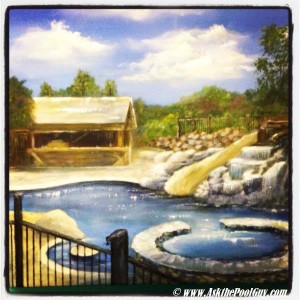 How to keep your pool properly chlorinated in the winter
How to keep your pool properly chlorinated in the winter
Most people think winter months=less pool maintenance. While that may be true, your pool still needs attention and care in the winter months just as much as it needs in the summer months. Pools are less likely to develop algae as quickly in the winter than they are in the summer; therefore you do not need to dose your pool with chlorine as often in the winter. They still have the ability to grow algae and winter pool damage can severely affect your summer swimming abilities and your wallet.
What is the best way to make sure your pool is properly chlorinated?
1. Figure out the magic number
Every pool needs a specific amount of chlorine to keep things working properly, and it can be a guessing game to find that magic number. Here is a basic formula to help you figure out that number:
- Liquid: 400mL per 3785 liters (around 1,000 gallons)
- Granules: 850gm per 3785 liters
- Tablets: 1 tablet per 3785 liters
As a general rule, tablets are used weekly and liquids and granules are used just about every other day. Sometimes the particular chemical you are using on your pool may need a specific dose outside of this formula, so be sure to check the labels.
WARNING: Never mix chemicals, that includes different types of chlorine
2. Fix any pH or water imbalance issues
One of the simplest ways to make sure your pool water is balanced is to take a sample to your local pool store. The staff can assist you and tell you exactly what is going on with your water, if there are any issues, and how to resolve them. They can also advise you on the right products for the job.
A convenient and simple way to maintain the ideal balance of your pool water is by using an automatic chemical feeder. The automatic feeders are especially useful during the cold winter months when you might not want to spend your time outside trying to take pool samples.
3. Clean filters
Chlorine does a great job of killing bacteria in your pool but it won’t get rid of organic and inorganic debris. To make sure there is nothing gross floating in the water or stuck in the filtration system, keep your filters clean.
4. Super Chlorination
Once in a while, that regular dose of chlorine just won’t do. This is when you need to shock your pool. It will rid your pool water of combined chlorine that can cause bad skin irritation or bad odors. Here are three simple steps to properly shock your pool:
- Figure out how much combined chlorine is in your pool water (use a DPD kit or test strip).
- Calculate how much shock treatment you need (once you figure out the amount of combined chlorine in your pool, you need to add about ten times that amount of chlorine to eliminate it).
- Add the shock treatment (then wait a few hours before swimming).
*Salt Chlorination- Installing a salt chlorinator can be a great alternative to administering chlorine by hand. It also uses less chemicals, thus exposing less chemicals to you and your family. However, even when using a salt chlorinator you will need to shock your pool regularly. You may also need to add liquid chlorine at times when there is a high number of people using the pool.
